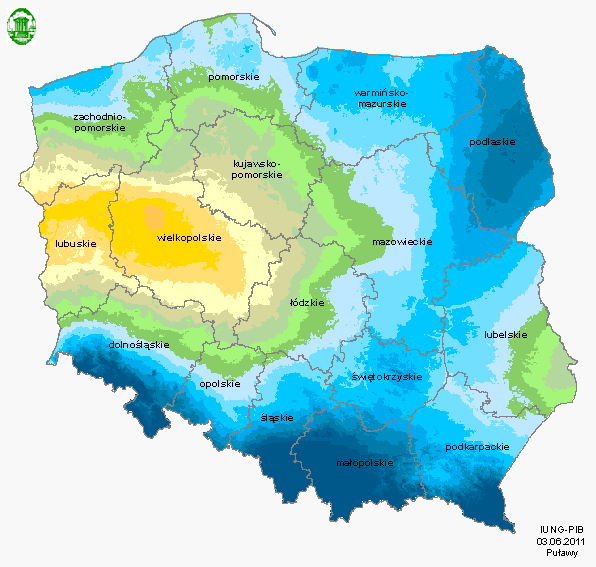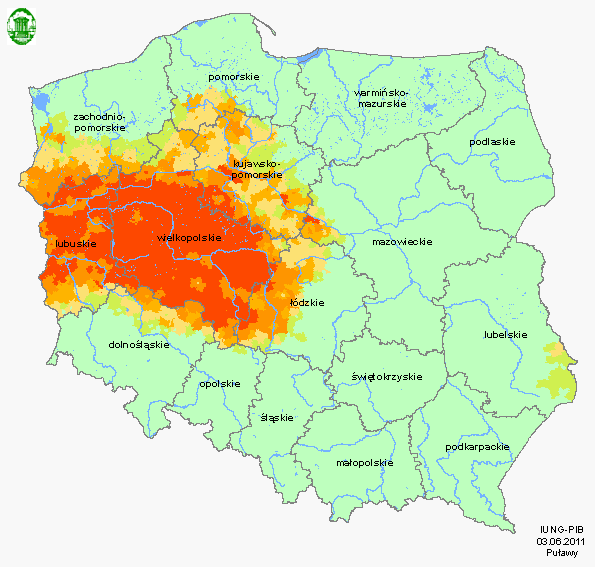ARCHIVES (2011)
Do roku 2016 raport oznaczony numerem 1 był tworzony za okres od 1 kwietnia do 31 maja. Od roku 2017 analizy są wykonywane o dekadę wcześniej czyli 1 raport oznacza okres od 21 marca do 20 maja
Communication report regarding the incidences of drought conditions in Poland
Year: 2011; period: 01 (1.IV - 31.V)
In the first reporting period from 1 April to 31 May 2011, we confirm a threat of agricultural drought in some regions of Poland. The value of climatic water balance (CWB), on the basis of which the risk assessment of drought is calculated in most parts of areas of Poland was negative.
A threat of drought occurs in 812 of local district in Poland (26.5% of the local districts) located in 10 voivodeships:
|
Voivodeship |
Number of threatened local districts |
Participation of threatened local districts [%] |
Participation threatened area in the area of voivodeship [%] |
|
wielkopolskie |
314 |
99,4 |
84,1 |
|
lubuskie |
112 |
96,6 |
72,1 |
|
kujawsko-pomorskie |
146 |
81,6 |
27,1 |
|
łódzkie |
94 |
46,5 |
20,2 |
|
zachodniopomorskie |
61 |
37,0 |
11,3 |
|
dolnośląskie |
39 |
14,4 |
6,7 |
|
pomorskie |
16 |
11,4 |
2,9 |
|
lubelskie |
13 |
5,6 |
0,2 |
|
mazowieckie |
16 |
4,4 |
1,3 |
|
opolskie |
1 |
1,0 |
0,0 |
The drought can be found among the winter and spring cereals, fruit bushes, strawberries and fruit trees grown on certain soils:
• Category I (very light), a group of granulometric sand loose, dusty loose sand, loamy sand weak, loamy sand slightly dusty,
• Category II (light), a group of granulometric: light loamy sand, loamy sand dusty light, strong loamy sand, loamy sand strong dusty.
The lowest values of CWB occur in the Wielkopolskie and Lubuskie voivodeships. Almost throughout both voivodeships, the CWB ranges from -160 to -199 mm. Outside that area to the north, east, and south, the CWB values are steadily rising, reaching values from -99 to -90 mm in Zachodniopomorskie (just on the coast), Warmińsko-Mazurskie, Podlaskie, Mazowieckie (in the eastern part), Świetokrzyskie, Śląskie, Opolskie, and Dolnośląskie.
A large water deficit also occurs in the south-eastern part of the Lubelskie voivodeship from -120 to -149 mm.
Only in the south of the country CWB values were greater than -50 mm.
April of this year was very warm. The highest temperature occurred in the Wielkopolsko-Kujawskim Lakeland reaching 11-12oC and the Lubuskie Lake District, even more than 12oC, in other areas of the country the air temperature was also high from 9 to 11°C. Only in the eastern part of Embankment of Zachodniopomorskie near Suwalki and the temperature was slightly lower and amounted to 7-9oC, but it was higher than the average long-term value (from three decades from 1971 to 2000) from 1 to 2°C. In the eastern part of the Poland temperature in April was higher than the average long by 2-3°C, in the western part of 3-4oC.
This year, April in terms of precipitation was very irregular. Very low rainfall, less than 30 mm occurred in western Poland, which accounted for 50% below the standard of many years. However, in the north-western and western parts of the country rainfall ranged from 10 to 20 mm and even below 10 mm (Wielkopolska), which accounted for approximately 20% of the norm for this region. In the east and south of the country, the rainfall was higher, at 40-60 mm (about 100% of normal). The highest rainfall, over 100 mm, occurred in Pogórze Śląskie, Beskid Śląski and Beskid Żywiecki, reaching 150% - 160% of the norm.
The air temperature in May was very diverse. Earlier in the month, almost in the whole of the country were ground frosts (May 2-6), particularly acute in Wielkopolska and Kujawy (the temperature drops even to minus 7oC). The other half, especially the last ten days of the month was very warm. The highest temperature occurred (as in April), in the Lubuskie Lake District and the Wielkopolskie (14-15oC), and the lowest was in the Pobrzeżu Gdanskim (11-12oC), in the rest of Poland (12-14oC).
In May, just as in April, the lowest rainfall occurred in Wielkopolska and Kujawy (less than 30 mm), which accounted for 60% of long-term standards. Slightly larger but low rainfall occurred in the eastern part of the Pobrzeże Zachodniopomorskie and in the southeast Lubelskie (30-40 mm, 60-70% of norm). The highest rainfall, as in April, occurred in Pogórze Śląskie, Beskid Śląski and Beskid Żywiecki (80-120 mm, 100% of norm). In the remaining area of Poland, the rainfall ranged from 40 to 80 mm.
Reports
- Report 13 (1.VIII - 30.IX)
- Report 12 (21.VII - 20.IX)
- Report 11 (11.VII - 10.IX)
- Report 10 (1.VII - 31.VIII)
- Report 09 (21.VI - 20.VIII)
- Report 08 (11.VI - 10.VIII)
- Report 07 (1.VI - 31.VII)
- Report 06 (21.V - 20.VII)
- Report 05 (11.V - 10.VII) +
- Report 04 (1.V - 30.VI) +
- Report 03 (21.IV - 20.VI) +
- Report 02 (11.IV - 10.VI) +
- Report 01 (1.IV - 31.V) +





